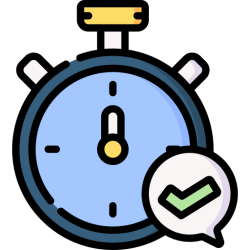Online Marketing Business
5 Ways You Waste Time Every Day

Do you find yourself at the end of a day wondering just what you have managed to accomplish? Are you wasting valuable time each day?
If the answer is yes, check out the most common five ways you waste time every day. Be honest, do you find yourself doing any of them?
I’m sure you will be guilty of at least one of them as modern life is so full of things that can distract us from getting things done.
If that sounds a bit like you then this post will hopefully help you to become more productive each and every day by becoming aware of these distractions and time sinks and managing to avoid them to get stuff done.
You’ll also find some handy time management strategies in here too.
They can help you become more efficient and productive and be able to get the most out of your day.
Are you ready? Let’s get started…
5 Of The Biggest Timewasters Of Your Day

Even if you’re one of the more dedicated and organized people out there, you still waste time. Whether you work from home or in the office, we’re all guilty of getting distracted and losing focus.
It may not be deliberate, and you probably don’t even realize you’re doing it until it’s too late.
Here are five ways you waste time every day. See if you can relate.
1. Social Media/Emails/Texts

This is the big one and I can pretty much guarantee that everyone reading this post is or has been guilty of this one!
It’s become a vital part of our lives. But the world won’t stop turning if you don’t look at your social media for 15 minutes.
Picture this scenario: you’re in the middle of work when your phone beeps. You reach for your phone to see your incoming message. So, you go from message to email to Facebook to Instagram. Then, when you’re done, you notice that 20 minutes have gone by.
Research shows that each time you get distracted, even for a couple of minutes, your brain needs more than 20 minutes to refocus. Imagine how much wasted time that amounts to at the end of the day!
The Fix: Avoid randomly checking social media, emails, or texts. Instead, set up a certain time during your day for doing just that. In the meantime, turn off any notifications or mute your phone.
2. Organizing And Preparing

You’re probably wondering: how is this a time-waster?
The Fix: Find an online planner and to-do-list. Then, pick one day out of the week where you plan out the whole seven days in advance.
Schedule in work-related projects, meetings, and deadlines. You can also include a workout schedule and get-togethers with friends.
3. Multitasking

Multitasking: another thing that we do to trick ourselves into believing we’re being productive. Yet, the sad truth is, multitasking wastes a ton of time.
The Fix: It’s simple. Just put all your attention and focus on one task at a time. When you’re done, move on to the next task, and so on.
4. Checking The News

In this day and age, it seems something is happening in the news every five minutes. So, it’s easy to use the news as an excuse for procrastination. After all, we all want to be in the loop when it comes to politics, sports, and local news.
One great example is the Stay Focused Chrome app. It helps you ‘hide’ certain websites for, say, 45 minutes. Then, tell the app you want to spend 20 minutes on the so-and-so website. After the 20 minutes are done, the app will block you again until your next break.
5. Errands And Chores

The problem isn’t with the errands or chores themselves; it’s when you do them. Running errands during rush hour is one of the biggest time wasters ever!
Doing chores is another. You might be sitting at your desk, working away when you notice a dusty shelf or a cluttered drawer. So, you do the responsible thing and start dusting and decluttering.
The Fix: Plan your errands ahead when you know there’ll be less traffic. Also, try to do your shopping when you know the stores won’t be as crowded and they’re in their least peak hours.
As for chores, set up one or two days during the week when you do all the dusting, cleaning, and decluttering. This way, even if you see catches your attention, you can push back in your mind and wait until ‘chore day’ rolls around.
A Final Note
We all get the same amount of time each day: 86,2400 seconds, 1,440 minutes, or 24 hours. It’s up to you to figure out how you’re going to spend that time. Sadly, many of us spend our days doing things that don’t really add any value to our lives—or anyone else’s for that matter.
OK, there are 5 ways you are wasting time every day. If you want to learn more time management strategies to make you more productive, then click on the featured resource below to download a free report that you can read at your leisure. Download, read it and take action 🙂

Why You Should Write Blog Posts On A Regular Basis

If you are a blog owner, you should post articles and other content on your blog regularly. How often you should post depends on your niche and your following.
You need to keep track of your visitors, where they are navigating to on your blog and how often they return. You do this by getting subscribers. Keep track of the percentage of subscribers and un-subscribers and this will be an indicator of how often to post to your blog.
If you notice there are a lot of people who unsubscribe from your blog on a daily basis, this is usually an indicator you are posting too much.
Keep an eye on this for a while and change the frequency at which you post to your blog. Not posting often enough is usually the problem blog owners have though.
Another problem bloggers run into is creating content that is intriguing and “draws a reader in” to want to read more. Sometimes it is hard to think of ways to do this and bloggers continue to just post information about their niche, products, or services.
You are supposed to do this, but there are other techniques to grab a reader’s attention. For instance, you want the blog to be personable and write in such a way it is like you are talking to the reader.
Tell A Story

You can write a story of something that happens to you each day, or a current event that is happening in the world.
You also write it as if it just happened. This will make the content seem very current.
All you really need to do at this point is create a bunch of stories of events in your life and have them scheduled to post on your blog.
You can also schedule them to be announced on your social media accounts.
Schedule Your Content

The best results come from having your content scheduled a week or more ahead of time. It is recommended to create about seven to ten articles beforehand.
Then when you are ready and have content prepared and edited, schedule the dates they should be posted. WordPress has a feature where you can do this.
But just posting to one blog may limit your audience. There are many other people who use other blog software such as Blogger. It is a good idea if you only have WordPress to have a blogger account.
Having more than one blog can seem like a chore; however, there are a variety of tools out there to help you keep both filled with content.
You will find some tools that can be set up to post to each blog simultaneously. You also have plugins in WordPress that will allow you to do this as well. It cuts down the time it takes to post to all of your accounts separately.
Spread The Word

Now that you have this established and set up, you will find you need to let people know you are posting to your blog and also let some people know that you have a blog in the first place.
Using tools and plugins available on the web and on WordPress can do this. There are tools when you make a blog post, it will automatically Tweet the announcement or update your status on Facebook.
Nothing is exactly automatic, but there are tools out there, which allow you to schedule your posts ahead of time. So as you plan your business and what you are going to write, you can add these posts to a tool and schedule the date and time you want people to see it.
On a side note, you want to schedule the times to reflect the time of day at which most people will see your posts.
Always remember, people want instant gratification. Depending on your view, some people believe there is no way to have it while others know there is.
You want to be the person who always finds a way to satisfy this part of our nature as humans. Those are the people who see much success as in sales increases, more fans, and even more ideas.
You will also notice you have more time on your hands to create awesome content your fans will love.
Remember that planning ahead of the game will allow for the smoothest experience running your own business.
Being consistent and updating everything from your blog to your social media accounts on a regular basis pays off handsomely in the end.
You will shortly begin to realize how often to post to your account by the number of fans you gain and even the amount you lose. And once everything is set up to work for you, you will see how well it pays off.

How To Beat Procrastination And Get Writing
 The American author, Joseph Heller, once said, “Every writer I know has trouble writing.”
The American author, Joseph Heller, once said, “Every writer I know has trouble writing.”
And he’s not the only one who has alluded to the difficulty of writing.
Stephen King’s quote, “Amateurs sit and wait for inspiration, the rest of us just get up and go to work.” – reinforces the same point.
Writing is hard work. It just is.
Even if you’re a good writer with a flair for the art, the act of putting pen to paper (or keyboard to screen) is almost always met with some internal resistance.
In fact, Steven Pressfield, wrote an entire book on it and called it ‘The War of Art’.
And it really is a war.
The anticipation of writing has struck fear in many a budding writer’s heart and caused them to procrastinate into eternity.
The road to publishing success is littered with the dusty skeletons of many wannabe writers who abandoned their writing halfway… and even more who never got started.
All due to procrastination.
The key to overcoming procrastination and getting your writing done will come down to you applying a few simple techniques.
1. Make It A Habit

The importance of a daily routine cannot be overstated. You have to make writing a habit.
What does that mean?
It means you have to spend some time writing every single day. You should also aim to make it the same time daily.
For example, sitting down at the same desk at the same place, every single day at 9 AM to write.
But should you write on weekends?
Only you can answer this question. If you face immense resistance within yourself before you can write, that means the procrastination force is strong with you – and not in a good way.
It would be wise to write on weekends too, but for a shorter duration so that inertia/resistance never gets a chance to build up, and you also have more time to rest. Even 20-30 minutes of writing will do.
It’s the habit you’re focusing on. An object in motion stays in motion. An object at rest stays at rest – and procrastinates while at rest.
2. Write In Blocks

How much you can write and how long you can write will depend on your typing/writing speed and your writing ‘stamina’. An experienced writer may be able to write for 4 hours at a go without any breaks.
For example, you may write from 9-11 AM and take a break for an hour and write again from 12-2 PM. In this way, you’d get 4 hours of writing done.
Depending on your writing stamina, initially you may wish to go with 30-minute writing sprints, followed by a 15-minute break and then another 30 minutes and so on. You could use a Pomodoro timer to help you.
There’s no right or wrong answer here. As long as you’re striving to build your writing stamina, you’re on the ‘write’ track. Pun fully intended.
3. Batch Similar Tasks Together

Planning, researching, outlining, writing and editing are 5 DIFFERENT tasks. Never try to do them all at the same time. This will not only tire you out but is also very time-consuming and unproductive.
Batching your tasks means getting similar tasks done at once. This not only simplifies the process but helps to accelerate it while increasing your output. It’s a win-win-win situation.
For example, if your goal is to write 10 articles on gardening, your first task will be to decide what topics you’ll cover.
Then you’ll need to do your research for ALL 10 articles.
When all that’s done, now you’re ready to start writing… and keep writing without editing.
Always remember the quote, “Write drunk. Edit sober”.
Once you’ve written all 10 articles, you can edit them individually. By batching your tasks in this way, you’ll save time and your writing process will not be a disjointed and discombobulated one.
4. Focus On Quality, Not Perfection

Avoid perfectionism at all cost. It’s not natural, and nothing is ever perfect. The goal is to aim for excellence. Write quality content that you can be proud of.
Do not focus on the quantity of the content. This is an unreliable metric to rely on.
You may notice that on some days, all you may manage is 5 pages in 2 hours. Yet, your writing for these 5 pages may be far superior than the 15 pages you wrote another day.
Good writing takes time. Quality and quantity are two different metrics.
Your goal is to write content that informs and moves your readers – and you want to do so in as few words as possible. That’s real skill and a sign of good writing.
Focus on quality and forget about quantity. You’re not planting rice here.
5. Use The Two-Minute Rule

This rule was first mentioned by author, David Allen, and it’s a very powerful technique of overcoming procrastination. It works with most activities that people tend to procrastinate. E.g. exercise, writing, studying, etc.
The rule is simple. When you’re facing a task that you don’t wish to do (like writing), you should give yourself just 2 minutes to work on it.
It’s as simple as that. 2 short minutes.
Very often, you’ll notice that once you start writing for 2 minutes, you’ll carry on long after the 2 minutes are over. You just might write for the next 2 hours.
You’ll then wonder what made you hesitate for so long. It wasn’t that bad, was it?
Of course not.
You’ve just discovered a mysterious anomaly when it comes to writing… getting yourself to sit down and start is usually far more difficult than the actual act of writing.
But now, you have the key to beat Captain Procrastination of the writing universe aka you – all it takes is 2 minutes.
In conclusion, it’s important to understand that the act of writing is not as dreadful as the thought of doing it. In fact, you might actually enjoy the process and find that it unleashes your creativity and may also be cathartic.
Apply the 5 pointers in this article and you’ll put an end to procrastination and be able to write – without first checking your emails 382 times as you try to delay the inevitable.
It’s easy once you start.
“Start writing no matter what. The water does not flow until the faucet is turned on.”
– Louis L’Amour
And don’t forget to enjoy the journey along the way. So many of us are totally fixated on the end result that we forget to enjoy the personal growth and achievement that happens along the way.
If that’s you then please check out this training that will encourage you to embrace the process and enjoy the journey so you can feel fulfilled before you even reach your goals which is a real win-win situation 😊

2 Questions You Need To Answer As An Affiliate Marketer

As you are reading this post, you must already realise that affiliate marketing is a great way to start an online business quickly.
But it isn’t always as straightforward as it seems and you may have some questions such as “Do I need to build an email list as an affiliate marketer?” or Do I need my own website to do affiliate marketing?”
In this article we are going to take a look at these two important questions.
Firstly, we’ll take a look at whether you do need to build your own email list when affiliate marketing and then we’ll look at whether you really do need your own website to really succeed as an affiliate marketer.
Ready? Let’s get started…
Do Affiliate Marketers Need To Build A List?

When embarking on an affiliate marketing career, you’ll need to determine if you want to build a list of emails from customers. Whether or not to build a list depends on the type of affiliate marketing you plan to pursue.
Building a list works well for products in specific niches. For example, the weight loss, health, and parenting niches offer opportunities for you to promote multiple products over a period of time. You’ll find a wide variety of products that fit different needs of your customer base.
When you have a list, you can capture the names and email addresses of potential customers so that when a new product is available, you can share it quickly and easily. You’ll need a program specifically designed for email marketing – such as Active Campaign or Aweber.
Using Active Campaign or Aweber, you can create sign up forms that you can add to your blog and squeeze page where people can enter their name and email address. You can also add special categories to help you get to know your customer better, such as the top weight loss problem or parenting concern they have.
Once you’ve captured emails, you can use the program to send different types of messages. Broadcast messages are often used to announce specials or just generally communicate with your list. They’re sent one time to the current subscribers.
Building a list doesn’t happen instantly – it’s another area in affiliate marketing where you will grow over time. You’ll start with no one on your list and gradually begin to see it increase. The larger your list, the more people you can reach to promote products.
It’s important to treat your list with care and respect so that people will want to hear what you have to share with them. You’ll want to make sure not to share any of the information you gather or submit your list to constant spam type messages.
Another question you may have is about having your own website as an affiliate marketer; is it required?
Well, let’s take a look at that now 😊
Do You Need A Website To Be An Affiliate Marketer?

As an affiliate marketer, you may wonder if you need to have your own website in order to succeed in the business. While it’s certainly a good idea to have your own website, there are many options that don’t require you to do that.
For example, you can use third party platforms that allow you to promote products. Examples include HubPages and InfoBarrel. These sites are relatively easy to use and can help you make a profit in affiliate marketing. You can write articles with affiliate links in them and you can generate income from the links and from the articles themselves as these sites operate a revenue share scheme. You can also do a similar thing with Medium too.
You can also get hosting for a free blog. For example, BlogSpot allows you to create a free blog where you can promote products. The one thing you need to be aware of, though, before you use third party platforms – is that you’re subject to their rules.
At any time, the rules may change and your blog might disappear or your pages may become obsolete. You just don’t have much control over your business when you choose these options. In fact, you can have the business you’ve worked hard to build that gets deleted in an instant.
If you are looking to buy a domain name Namecheap is a great place to look and if you are looking for hosting you won’t go wrong with either A2 or Siteground.
It’s very simple to set up a blog on your own site and you don’t have to worry about conforming to anyone else’s rules about what can and can’t be done on it. Then you can use third party platforms as a support mechanism and even to drive traffic to your blog.
You’ll find that it doesn’t cost as much as you might think to have your own site in your chosen niche and truly be the master of your own affiliate marketing business. This small investment (of about $10 a year for a domain and less than $10 a month in hosting) can bring big payoffs and is worth your efforts.
As an affiliate marketer, you don’t have to have your own website. But depending on third party platforms alone can be a risky decision. The best option is to have your own website and take advantage of third party platforms to supplement what you’re doing on your own site.
This way you get the best of both worlds and have multiple streams of income to support your affiliate marketing career.
If you want to know more about affiliate marketing then check out the featured resource below for a free report; download it read it and take action 🙂

Use Blog Challenges To Coach New Online Marketers

If you’re an Internet marketer who teaches Internet marketing to others, it’s important to help the readers of your blog learn how to adapt to a blogging ritual seamlessly.
Blogging is one of those tasks that many new marketers jump into without understanding how it works. They know they need to blog (because all of the top successful marketers do), and maybe for a few days – or even weeks – they stick to it religiously.
They sit there staring at the screen, unable to decide what they’re going to blog about. Sometimes they start swiping other people’s content because they don’t want to lose the momentum of posting daily.
They might grab something from an article directory or buy some PLR content and use it as is. This is where they start getting lazy, not because they want to be, but because they’re simply lost on what topic to discuss.
Others don’t want to neglect their blog – but the formidable task of trying to juggle a myriad of Internet marketing items on their to do list prevents them from getting to their blog – they’ve backburnered it and soon it’s forgotten and stagnant.
You can host a blog challenge for your readers that will help them in any niche! Whether they’re marketing bloggers, or they have a blog on gardens, insomnia, or dating – your challenge will help them take action, stay committed and view you as a leader.
OK, let’s crack on…
What Blogging Challenges Do Your Readers Suffer From?

You should be able to listen to your subscribers and see some common themes among them when they come to you with blog problems. If you don’t have subscribers yet (that you know of since many are lurkers), then you might have to read other blog comments or look in forums to see what issues people have.
Finding topics is a common problem for many bloggers. People sit there staring at their screen, or they go to someone else’s blog to see what they’re talking about.
They key is to help them learn how to find topics – how to dig up new slants and fresh ideas and give commentary on them.
Making an engaging connection is a big deal – and so many marketers falter with this. Everyone wants to see blog comments or get emails about how amazing their blog post was!
Monetizing their blog post could be an issue. You wouldn’t believe how many bloggers are sitting there wondering why their blog isn’t making money, when the only problem is, they forgot to add links!
Consistency is probably the number one problem, though. People get sidetracked and for some reason, their blog – what should be their “home on the ‘net” – is what usually suffers.
Preparing Your Blog Challenge Ahead Of Time

Hosting a blog challenge is a great way to get a ton of branding for your blog, as well as traffic and comments for it, too. You want to go into this well-prepared, not floundering right alongside your readers – they’re expecting you to guide them!
First, announce the date ahead of time. Get everyone geared up to participate. Have them sign up – either simply by announcing their participation in the comments section of your blog, or by having them sign up to your email autoresponder list.
Let them know what the basic challenge will be. Create a list of rules, but don’t make it so stringent that people feel like labeling themselves failures. You want to inspire them and encourage them to keep going even if they miss a blog post.
Map out your helpful blog posts that you’re going to create along the way. You will be blogging daily to give tips and ideas, share your own entry to the challenge, and create a space for them to discuss it and encourage each other.
Some people might want you to create a forum for the discussions. Keep it on your blog. As the host of the challenge, your blog will benefit from the traffic and conversations taking place.
Give them any tools and tutorials you think they’ll need. If your blog challenge is to have them get comments, then you might steer them towards something like Disqus and give a tutorial on how that works.
This is not only a good way to be a leader, but it can help you make affiliate sales of certain links for people’s blogs, like paid plugins or WordPress themes, for example.
Supporting Your Challengers

As the host, it’s your job to support the people who are following you and participating in your challenge. Now if you have hundreds of people, it might be more difficult – in that case, you can just encourage people to support each other.
Allow them to share their blog post link. You can let them leave it in the actual comment as a live link, use a tool like Disqus, or just have their name hyperlinked to their website.
Leave a comment for them to show them they have traffic and encourage comments and sharing by others. By the time the challenge is over, they will have a thriving community – many will stay and at the very least, it shows search engines and new visitors that this person has an active blog!
Check in with those who stray. When everyone signs up, make a list of the name and email of the people participating. If you notice someone falling by the wayside, shoot them a friendly email of support. Sometimes they just need to be nudged.
Challenge Idea #1: Encourage New Media Formats

Blogging isn’t just about text blog content, although that is the most prevalent for of blogging that there is.
You can host a challenge that urges participants to get used to multiple media formats.
This will get people out of their comfort zones, but it will help them learn how to cater to many of their subscribers across the board. When the challenge is finished, they’ll be able to use more than one format and switch things up for their audience.
Challenge Idea #2: 1-A-Day Affiliate Marketing Reviews

Because affiliate marketing can be so profitable through the use of a blog platform, it’s important that you help your readers learn how to master this.
For your affiliate blogging challenge, have some guideline steps like this:
- Pick one product over $25 (or $50 or $100 or whatever)
- Make sure it’s rated at least 4 stars
- Write a review of at least 500 words per blog post
- Each blog post should have specs, pros, cons, and consumer insight
- Blog posts should have at least 2 hyperlinks to product (*Optional – 1 hyperlink to a top competitor product)
These kinds of details will help them from getting stuck trying to decide between one product and another. It also gives them guidance on the structure of the blog post.
Challenge Idea #3: Thought-Provoking Shareable Content

These are fantastic challenges to do on your blog. The concept of this challenge is pure 100% quality. You’re asking your readers to create blog posts that knock the socks off of their readers.
This isn’t about monetizing the exact blog post – but it can result in increased income because they gain a loyal following. This is definitely one you’ll want to give them time to map out a couple of weeks ahead of schedule.
The goal here is to make sure they have their social networking buttons working. You want their visitors Tweeting, Google + sharing and Facebook sharing these blog posts because they’re that good.
Challenge Idea #4: Curated Blog Content

Curation is a buzzword in marketing circles, but it’s a fantastic way to build a blog readership! First, you need to explain to your readers what curation means. You don’t want them getting confused and swiping other people’s content and plagiarizing it.
Curation is when you act similar to how a museum curator acts – gathering pieces to represent a concept as a whole. The curator then provides commentary about the pieces to pull it all together.
They can curate a video from YouTube, a news story, or an audio file quote. Make sure they understand that it’s not about sharing someone else’s work – it’s about adding their own insight about that work and giving the original creator credit with a link.
Curation doesn’t always have to be positive. It can be a negative curation, where they’re showing poor examples of something. Just make sure they understand they might get some heat for this from the first author.
Challenge Idea #5: One Idea Fits Everyone

This is a good twist, but only if everyone is in the same niche. If you’re teaching other marketers, then this would be a viable possibility. If you have one in the gardening niche, another in dating and one in smoking cessation, this won’t work.
Everyone in the challenge would write about that topic. It’s interesting to see what slants people have on issues. So for instance, you might have these on your list:
- Top 5 Conversion Tips
- Review of the Plugin ThriveLeads
- Is JVZoo Better Than ClickBank?
Whatever topic you want to choose – see what the slants turn out to be after they are published. Don’t tell them what to write, just give them the basics. Your group will love being in these blog challenges and seeing their productivity soar!
By the way, if you want to know more about blogging the right way, why not check out the featured resource below for a free blogging report. Download, read it and take action 😊









